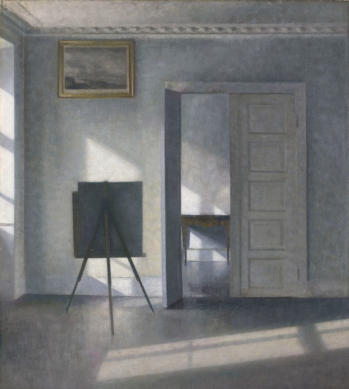Fine Art News > The J. Paul Getty Museum has acquired “Interior with an Easel, Bredgade 25,” painted in 1912 by Vilhelm Hammershøi (Danish, 1864–1916). The painting is now on view at the Getty Center in Los Angeles.
From the museum:
“‘Interior with an Easel, Bredgade 25’ is a characteristically luminous and enigmatic image that encapsulates Hammershøi’s particular visual poetry,” said Timothy Potts, director of the J. Paul Getty Museum.
“Hammershøi’s carefully orchestrated compositions are defined by their sparse atmospheric mood, using a few familiar pieces of furniture and the fall of light through a window to create some of the most beautiful, contemplative interiors in the history of painting. This work is especially important for its play on the art of painting itself: It is a painting about paintings — one seen from the back, on the easel, the other hanging on the wall. All that is missing, as so often in Hammershøi’s work, is the human protagonist — in this case the artist himself.
“There could be no more appropriate subject for the Getty Museum, or any museum, and we are delighted to be able to add this extraordinary work by one of the most important Scandinavian artists of the late 19th and early 20th centuries to our collection. Hammershøi clearly saw himself in the tradition of old master painters (he is often touted as ‘the modern Vermeer’), and I am sure visitors will see many resonances with our paintings by other great northern European artists, such as Caspar David Friedrich, Fernand Khnopff, and Edvard Munch.”
Hammershøi began depicting interiors in the late 1890s, and these austere and meditative paintings came to define his artistic reputation, already well established by the time he made “Interior with an Easel, Bredgade 25.” With single-minded focus, these interiors represent the apartments in Copenhagen that Hammershøi shared with his wife, Ida, and that served as his de facto studio (Bredgade 25 was the address of his final apartment).
Sometimes his work features his wife quietly absorbed in some domestic task, but frequently there is no human presence — the primary subject being the play of light in the sparsely furnished architectural space. Here the only props, besides the artist’s easel, are a framed painting hung high on the wall, to protect it from direct sunlight, and a small table in the far room, framed perfectly by the half-open doorway.
Well-known and highly regarded in his own lifetime, Hammershøi died of cancer at the age of 51. His work fell into relative obscurity, and for much of the 20th century he was scarcely known outside Denmark. Over the last few decades, however, there has been a resurgence of interest in Hammershøi’s work internationally, as numerous exhibitions in Europe, Asia, and the United States have attested.
His compositions’ rigorous geometry, sober palette, and lack of sentimental anecdote appeal greatly to modern sensibilities, while the domestic settings, refined painterly handling, and sophisticated light effects call to mind the European old master tradition, and particularly Dutch 17th-century painting. Tellingly, both Whistler’s and Vermeer’s names have been invoked in connection with Hammershøi’s art.
“‘Interior with an Easel, Bredgade 25’ is a work of great power and stark beauty, mesmerizing in its sense of stillness and silence. All the elements of a great Hammershøi are here: the masterful rendering of the cool Nordic light, the exquisitely nuanced tonal harmonies, the geometric rigor of the planar composition, the shimmering weave of small, textured brushstrokes — all working to transfigure the mundane into something haunting and poetic,” said Davide Gasparotto, senior curator of paintings at the Getty Museum. “Hammershøi is one of Denmark’s most fascinating painters, and the renewed interest and scholarship that his work is now receiving is well overdue.”
Sign up to receive Fine Art Today, the free weekly e-newsletter from
Fine Art Connoisseur magazine.







